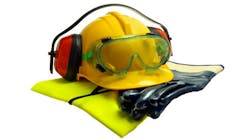Buying safety equipment and getting workers to use it are two entirely different things. Anecdotally, almost every safety professional I’ve spoken to finds it much easier to go shopping for the latest hard hat and safety glasses than getting workers to comply with PPE requirements.
The usual advice to improve compliance to provide new, more comfortable PPE that looks good. But what happens when you’ve purchased new protective equipment that fits well and looks good, but it still doesn’t get used when it should?
There are several often-overlooked ways to get workers to wear their PPE. In most cases, these are small changes in what many workplaces are actually doing—but collectively, they can lead to major improvements.
The Whys of Training
Training should cover more than how to properly wear PPE. It should also discuss why. One of the biggest causes of PPE noncompliance is that many workers simply don’t think they need it. When they’re asked why they aren’t wearing PPE, people will often say things like, “I just never thought to put it on.”
PPE trainers should take a cue from basic marketing tactics and present workers with more impactful value propositions. Explain why PPE use is necessary, make it feel urgent, and appeal to them with compelling stories.
Good stories are personal and relevant. One of my own go-to stories is about a time when I was walking through a worksite—and out of the blue, a rivet struck my hard hat. It had been dropped by someone working on a raised platform several stories up and could have caused serious damage if I hadn’t been wearing PPE.
This story works well because it demonstrates that wearing PPE is a practical choice we can make to protect against other people’s mistakes. It also shows that I personally believe in the value of PPE, and it provides a good prompt for a discussion about when it’s necessary to wear hard hats.
More than Monthly
If you want PPE use to become a regular practice, then you need to make it a regular topic of conversation. This means discussing PPE with workers at every opportunity and from every angle. Provide verbal refreshers of key teaching points from PPE training, talk about why it’s so important to wear PPE and chat about different situations in which workers may be tempted to remove their PPE so that people will be on the alert and prepared to act in the safest manner possible.
These refreshers can be delivered in a variety of ways. At the end of a one-on-one conversation with a worker, take a few moments to remind them about PPE issues. You can also discuss PPE when assigning workers to new tasks or when talking to them about non-safety elements of their job. Also consider more passive forms of reminders, such as noting PPE requirements in safety posters, and on video displays in break rooms and other common areas.
Many manufacturing companies already have group discussions built into the work schedule. In most cases, these are either monthly safety meetings or weekly toolbox talks. A short conversation about PPE can usually be worked into these meetings with minimal effort. But monthly discussions typically aren’t enough (especially because other safety issues also need to be covered).
When It’s Time for an Intervention
Sometimes proper training and regular toolbox talks on PPE isn’t enough to get everyone to comply. If someone consistently fails to wear their PPE, then it’s time to have a one-on-one conversation with them.
The conversation should be direct but it shouldn’t be focused on reprimanding the worker for unsafe actions. Instead, let the worker share why they think certain behavior is acceptable and then have the supervisor follow up with an explanation of the risks.
People are more likely to listen if they feel listened to in turn, and if they believe in the underlying need for PPE rules. So even when a frank conversation is required because someone isn’t wearing safety gloves or eye protection, it’s still important to focus not on current noncompliance but on desired behavior in the future.
From Decision to Habit
Every time a worker makes the decision to use PPE, there’s always a small chance they could choose to not use PPE. That’s why the goal is to transform PPE use into an unconscious habit.
It’s not something that happens overnight. In most cases, building safety habits requires a lot of small course corrections and encouragement, both of which come from group and individual conversations. Eventually, though, PPE use will go from being a rule that must be enforced to something that happens automatically.
Matthew Howard creates toolbox talks for Pro Toolbox Talks, a safety talk subscription service for EHS professionals.




